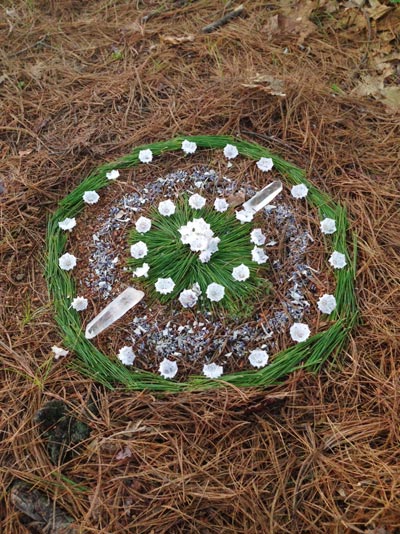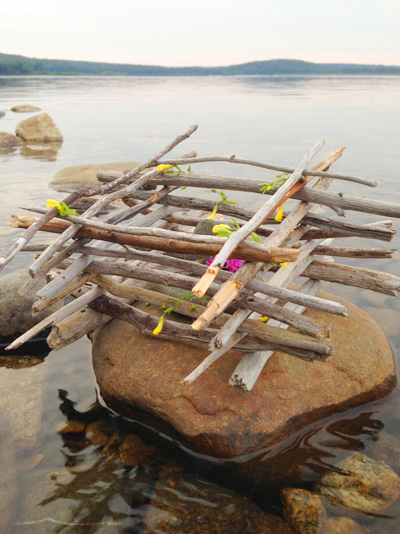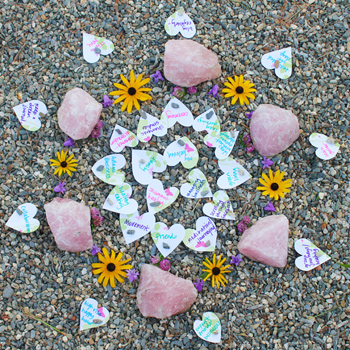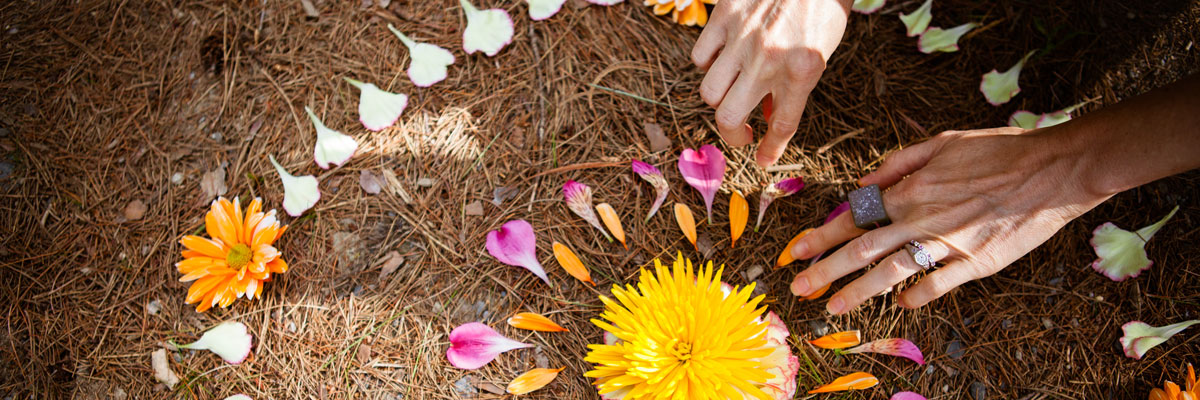“Creating ceremony is the art of ritualizing the beauty and magic that is actually taking place each moment of life.”
– Koelle Simpson, world-renown horse whisperer and life coach
Overview

Photo by Natalia KW
Creating your own ceremony is a beautiful way to make it an even more meaningful experience. While there are lots of established ceremonies, you don’t have to follow any of them. Your intention is what matters – Mother Earth and Spirit don’t care whether you stick to a script or not.
It’s important to emphasize that ceremony is religion-neutral. While all religions have specific ceremonies, all ceremonies are not religious. You do not have to ascribe to a religion to create personal ceremony, nor do you need to invoke Spirit. You may deeply connect with the world around you – where nature is your church.
If you do follow a particular faith, be assured that creating your own ceremony does not conflict with that faith but rather can be a part of it. You can express your faith by incorporating beliefs, songs, practices, and sacred objects (e.g., a rosary, bible, Koran, Torah, Buddha statue) into your own ceremony. This is yours to create as you wish.
You can certainly do ceremony alone – many of us do ceremony daily, working with an altar at home that has objects of special significance to us – but ceremony is even more powerful when people come together to combine their intent and energy. We are far more powerful united than we are alone, and ceremony is a fantastic way to bring people together.
Since it can be challenging to know where to begin, we’ve provided some framework, inspiration, and ideas here to get you started. If you haven’t read The Power of Ceremony, we encourage you to start there to get fully immersed in the ceremonial process.
Framework
As we discussed in The Power of Ceremony, ceremony has four primary components: intention, entering sacred space, transformation, and return.
1. Intention
Start by setting an intention for your ceremony. Intentions may involve requests for guidance, knowledge, or healing. Your intent could involve being fully in gratitude and communion. You may want to let go of some aspect of your life – or you may wish to call something in to your life.

Photo by Natalia KW
Get clear before you begin on why you’re doing ceremony and what you want to gain from it. As part of your intention, you also commit to being fully engaged in the ceremony process and open to whatever may occur, releasing control and reconnecting with the natural flow of our interconnection with Spirit.
Select a time and place for your ceremony. It could be at home, in nature, or any place that has particular meaning to you and ideally where you won’t be disturbed or distracted. This is your time, for you and those with whom you are doing ceremony. Honor that by creating this frame around the time and space so you can all engage more fully.
We strongly recommend doing ceremony outdoors whenever possible. It’s easier to avoid disturbance and to step out of ordinary life. Even more importantly, you can connect more deeply to nature and the larger world when you’re sitting in it versus when it’s an abstract idea in your head. And as an added bonus, simply being in nature is beautiful, calming, and restorative. When you do ceremony in nature, you power up this experience even more.
2. Entering Sacred Space
To be in ceremony means we step out of everyday ‘normal’ reality into a more heightened state of consciousness. We are physically and mentally present, engaging our senses. Having set our intention, we show up energetically, ready to enter into communion with Spirit and the larger world for awhile.
How do we create sacred space?

Photo by Natalia KW
Indigenous groups often invoke the Four Directions of the Medicine Wheel, calling in the archetypal energies and power animals of the East, South, West, and North, as well as connecting with the Mother Earth and Father Sky. They may ask for their ancestors to guide them in this ceremony and for it to be a place of support and healing.
You can do some version of this, or you can create your own. If you follow a specific faith tradition, you can use specific prayers, or you can make up your own. These prayers can be said silently, but to fully engage it is recommended that you say them out loud. Here are some other ideas:
- Light a candle
- Clear the space energetically by burning sage or incense
- Sit in a place of beauty, whether inside or outdoors
- Take some deep, meditative breaths or do yogic, pranayama breathing
- Play music with the sounds of nature or that puts you in a more meditative state
- Sing, chant, drum, rattle, or ring bells
- Dance or create some other movement
- Make a circle of beautiful stones or other nature elements and sit in the middle of it
This process prepares you and your group (if you are in one) for the transformation process. Adults and children alike get the opportunity to settle and separate from everyday reality to join their energies in this special place and time.
3. Transformation, the Heart of the Ceremony
This phase is unique to the ceremony that you are doing, based on your intention. Every ceremony, regardless of specific intention, however, should include some sort of offering as a way to express our intent, connection, and respect – like bringing a small gift when visiting friends. It is recommended that this offering be a thing of beauty, something that appeals to the senses:
- Sage, lavender, essential oils, incense
- Flowers, leaves, or herbs
- Wine or sweets
- Music, poetry, dance
These offerings may be made to the elements of nature. You can burn something in a fire, send it into the air, bury it in the earth, or pour it into the waters (as long as it is biodegradable). This honors your ceremony and puts you into right relationship with the world around you.

Photo by Natalia KW
Use your breath to imbue objects with your intention, love, and essence. When you make an offering or use any physical object (flowers, leaves, sage, etc.) in your ceremony, blow your breath onto the object first. Nearly every culture or religion talks about the importance of the breath as our life force. When you breathe on an offering, you are sending it with your love and deepest gratitude. When you breath into something that represents something you’re letting go or want to bring in, you make your intent to transform this issue strong.
Release. If you are releasing something, you could bury something that represents this in the ground, burn it in a fire, or pour it into a body of water. (Note that this is in addition to your offering – you offer something to honor your ceremony and then burn, bury, or pour what you want to release.) You may also say a prayer asking for help in letting this aspect of your life go – and for something new and more fulfilling to take its place.
Renewal. If you are renewing some aspect of your life or relationship, you may have something there that represents that aspect. Your prayers may focus on nurturing this aspect and asking for support as you deepen this relationship.
Reflection, Gratitude, Celebration. If you are reflecting on the wonders of life and offering gratitude and celebration, you may share stories, poetry, songs, or other ways to honor what or whom you are celebrating. You can spend time in quiet reflection, or you can drum, whistle, or sing. A remembrance ceremony of someone who has passed, for example, could include everyone sharing a favorite memory of the person.
Reshaping Who You Are. If you are changing your identity, you may include actions that represent this change. Traditional rites of passage ceremonies often involved a series of trials that, once completed, signified that a youth was ready to take on the privileges and responsibilities of adulthood in their community.

Photo by Natalia KW
In weddings, the first kiss, stepping over a broom, breaking a glass, and other traditions all reflect a the transformation from singlehood to entering a sacred union. If people have gone through a divorce, they may pray for ways to reclaim who they are, honor the relationship and the gifts that came with it, and move forward in a new way, leaving the past behind.
Creating ceremony is a beautiful art that comes from our hearts, and these are only a few examples. Remember that you can always keep it very simple – and that’s the best way to begin, as it helps you stay focused on your intention. Go somewhere special for awhile, say some prayers, and offer gratitude for the experience. Over time, you can add more to the experience.
4. Closing
Last, it is important to close the ceremony. This marks the end of being in a sacred space and the return to our everyday selves and our communities. You may close the ceremony the same way you opened it, or you may create another way of saying thank you for the experience and honoring all those who participated together.
Once the ceremony is completed, you can rejoice! Have some food, hang out, and enjoy the company of your fellow participants and the beauty of nature.
Share Your Ideas
We’d like to start a collection of ceremony ideas, so please share in the comments section below:
- Types of ceremonies you’ve held
- Aspects that were particularly meaningful
- Recommended resources
- Items you’ve used in ceremony
- Any other tips, suggestions, and recommendations you have for creating powerful and beautiful ceremony
Banner photo by Addie Roberge Photography.

